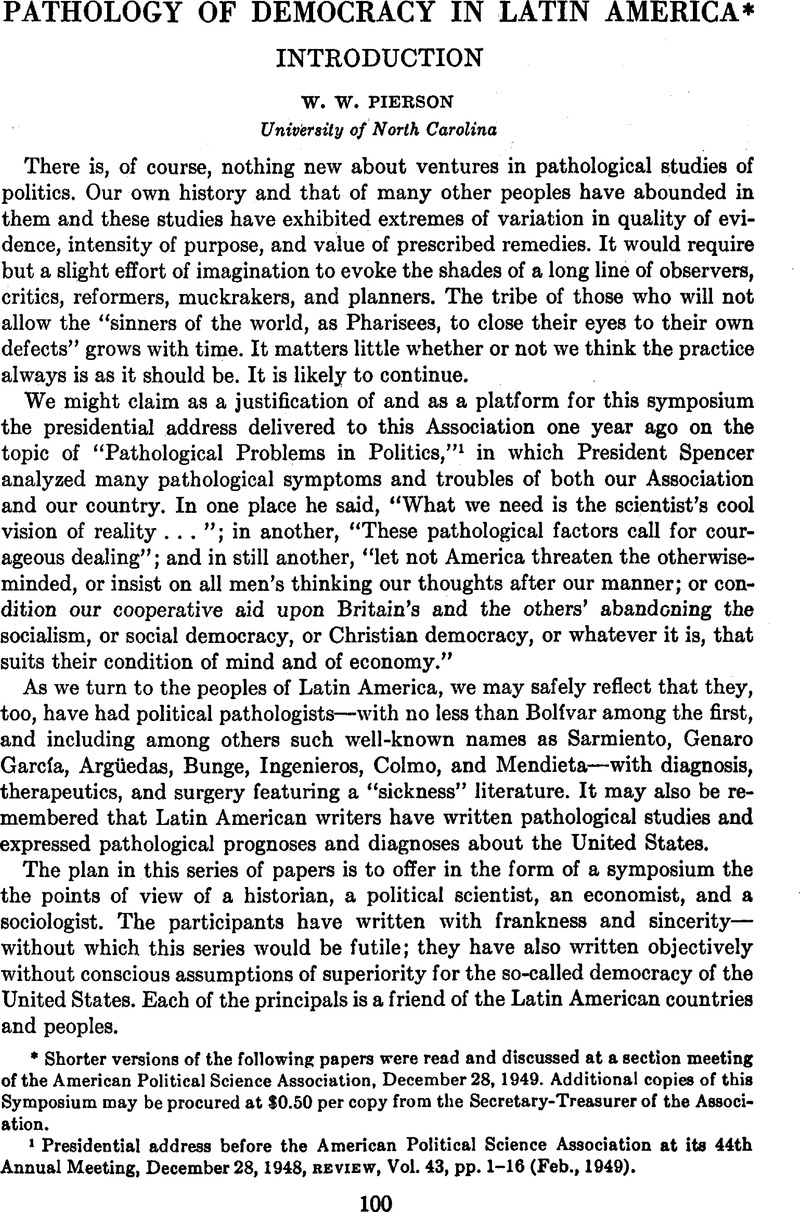No CrossRef data available.
Article contents
A Historian's Point of View
Published online by Cambridge University Press: 02 September 2013
Abstract

- Type
- Pathology of Democracy in Latin America: A Symposium
- Information
- Copyright
- Copyright © American Political Science Association 1950
References
1 “Democracy,” Encyclopaedia of the Social Sciences, Vol. 3, pp. 76–84Google Scholar.
2 Zavala, Silvio, La filosofía política en la conquista de América (Mexico, 1947)Google Scholar.
3 Bryce, James, South America; Observations and Impressions (New York, 1923), p. 581, n. 1Google Scholar.
4 Romero, José Luis, Las ideas políticas en Argentina (Mexico, 1946), p. 140Google Scholar.
5 Belaunde, Víctor Andrés, La crisis presente, 1914–1939 (Lima, 1940), p. 184Google Scholar.
6 Compendio de derecho público interno y externo …, cited by Belaunde, op. cit., p. 185, n. 1.
7 Calderón, Francisco García, Latin America: Its Rise and Progress (London, 1913), pp. 244–245Google Scholar.
8 Zea, Leopoldo, Dos etapas del pensamiento en Hispanoamérica: del romanticismo al positivismo (Mexico, 1949), p. 43Google Scholar.
9 Whitaker, Arthur P. (ed.), Inter-American Affairs, 1945 (New York, 1946), p. 58Google Scholar
10 Ayarragaray, Lucas, La anarquía argentina y el caudillismo (3d ed., Buenos Aires, 1935), p. 221Google Scholar.
11 Zea, op. cit., pp. 363–369.
12 Romero, op. cit., pp. 214–225.
13 Belaunde, op. cit., p. 99.
14 Ibid., part 3; “La nueva concepción del estado,” pp 177–256.
15 The following summary is drawn mainly from García Calderón, op. cit., pp. 365–377.
16 Bryce, op. cit. The following summary is based on pp. 523–551 and 570–586. Bryce illustrates the common exaggeration of the isolation of the Spanish Americans; see, for example, pp. 574, 580. He believed this isolation had “retarded their development” ever since the Conquest.
17 Humphreys, Robin A., The Evolution of Modern Latin America (New York, 1946), p. 80Google Scholar; Macdonald, Austin F., Latin American Politics and Government (New York, 1949), p. 2Google Scholar.
18 Calderón, Eduardo Caballero, Suramérica (Medellin, 1944), pp. 235–236Google Scholar. For a brief but instructive account of the rise of the middle class in Chile, the victory of democratic elements over the oligarchy, and the fiasco they soon suffered under the leadership of Arturo Alessandri, the “Lion of Tarapaca,” see Donoso, Ricardo, Desarrollo político y social de Chile desde la Constitución de 1833 (2d ed., Santiago de Chile, 1942), pp. 113–121Google Scholar. This little book is a notable exception to the neglect that the history of the Latin American countries in the post fifty or seventy-five years has suffered at the hands of historians in those countries.
19 Belaunde, op. cit., p. 80.
20 Whitaker, Arthur P., The United States and South America: The Northern Republics (Cambridge, 1948), pp. 195–206CrossRefGoogle Scholar.
21 Revista de Historia de América, No. 27, p. 136 (June, 1949)Google Scholar.
22 García, Antonio, Planificación municipal y presupuesto de inversiones (Bogota, 1949), p. 52Google Scholar.





Comments
No Comments have been published for this article.